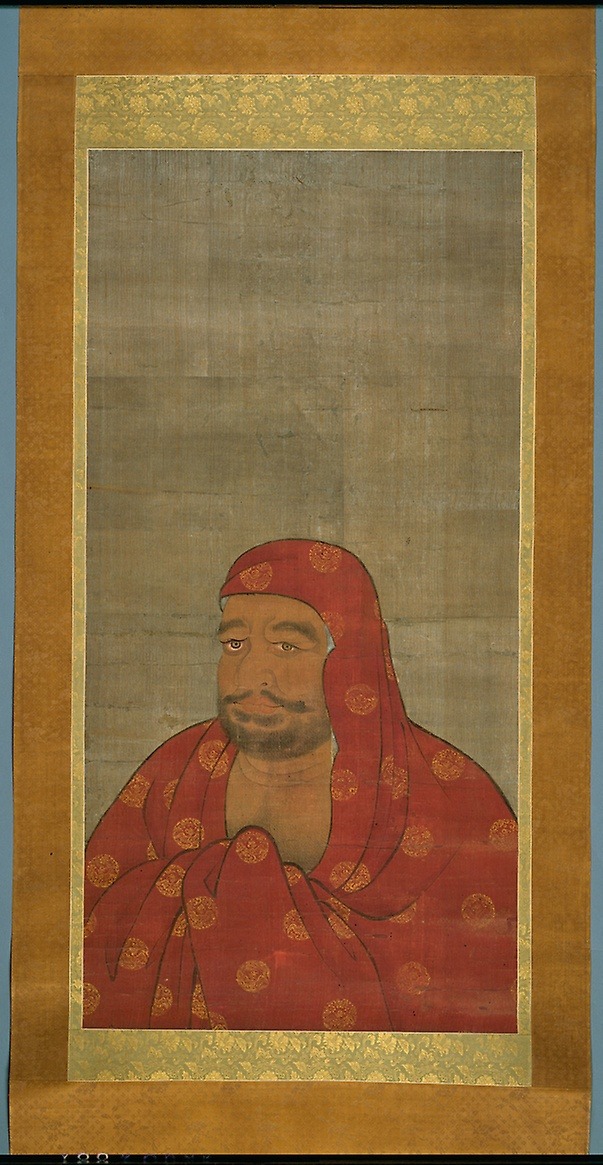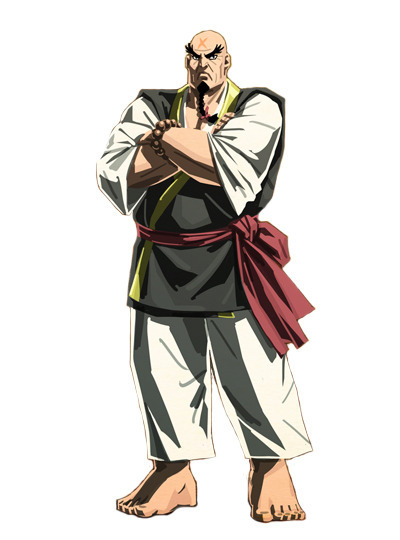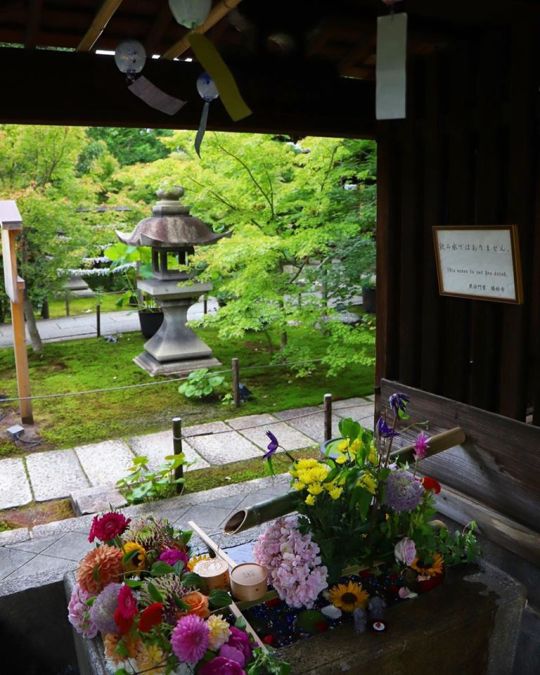#shorinji temple
Photo

Eleven-Faced Kannon Hokkeji
Nara period AD 710 to 794
Shorinji Temple, Nara Prefecture
#kannon#hokkeji#temple#shorinji#japan#nara#buddha#bodhisattva#buddhism#buddhist#religion#religious#art#history#japanese#sculpture#asia#asian#avalokiteshvara
836 notes
·
View notes
Photo

At Shorinji Temple, Japan. Photography by katsu_e46
94 notes
·
View notes
Photo

Daruma, 1545, Art Institute of Chicago: Asian Art
Zen rose to prominence in Japan in the 13th century, after receiving support from the ruling Kamakura shogunate. In this sect of Buddhism, images of patriarchs were especially revered because the relationships between masters and disciples are of primary importance to the transmission of Zen teachings. Zen’s semilegendary founder, Daruma (A.D. c. 470–c. 543), came from southern India and crossed the Yangzi River in China, where he meditated in a cave at the Shaolin monastery for nine years. In this Japanese painting, his facial features are Indian, and his head is covered as befits a southern Indian monk. According to an inscription on the back of this painting, it was originally in the possession of Shorinji temple in Okayama prefecture. Russell Tyson, Samuel M. Nickerson endowments
Size: 109.2 x 54 cm (43 x 21 1/4 in.)
Medium: Hanging scroll; ink, colors, and gold on silk
https://www.artic.edu/artworks/117201/
16 notes
·
View notes
Text
WHAT IS SHORINJI KEMPO
Shorinji Kempo is not just a martial art or self defense. Self-defense, blows, throws, joint locks, defense weapons and even meditation. The basis of Shorinji Kempo is not to raise poor warriors, but to develop people who can act, help others and create a better society.
Doshin So founded this style of Kempo in 1947 and elected to incorporate elements of Japanese Zen Buddhism into his techniques. It is widely regarded as being a religious and fighting form of Kempo, though there is a clear distinction between the technical side and the religious side of Shorinji Kempo. Branches of the style within Japan are called “doin” temples, whereas branches outside Japan are only recognized as “dojos.”
Shorinji kempo? You may have heard it mentioned as a legendary martial art or read about it in texts on judo and karate as an ancient Chinese-temple style. But shorinji kempo lives, and, what’s more, it’s growing. Thousands of Japanese practice it in more than 800 training halls. It’s spread through every major Japanese university and many of the nation’s high schools.
This martial art represents the physical, active aspect of Congo Zen. For Doshin So, it’s not just another empty martial art, but a whole way of life. Shorinji kempo combines elements of jujutsu styles that Doshin So learned from his grandfather, with many techniques and ideas learned from various quan fa masters during his time in China. He took these elements, and made them systematic, incorporating ideas and changes from his own experience. The four elements are the Kihon; it is the basic basics such as kicks and punches. The Hokei which is training in pairs. Randori was sparring. And Embu, a combination of strategies with one partner.
“Self defense, spiritual cultivation and improved health” 일본야동

3 notes
·
View notes
Text
instagram
Jizos are smiling with beautiful flowers.☺️☺️☺️
At Shorinji temple in Kyoto
#japan#trip#beautiful#kyoto#sightseeing#cool#art#gojapan#amazingjapan#kawaii#temple#shrine#jizo#jizos#Japanese#traditional#pottery#Instagram
2 notes
·
View notes
Text
The Violent Legend of Tea
In both Chinese and Japanese tradition, the discovery of tea is credited to the Indian sage Bodhidharma (aka Daruma), the founder of Zen Buddhism.
Bodhidharma, travelling to spread the word of his new doctrine, founded the Shaolin temple in southern China (or the Shorinji Temple to the Japanese). There he meditated while sitting facing a wall. For nine years. At the end of that period Bodhidarma's legs had withered away and he was just on the verge of reaching enlightenment, but then he fell asleep. He missed being enlightened -- all because he could not keep his eyes open. Enraged at missing the last, ultimate step, he ripped off his own eyelids and threw them to the ground. From them grew the first tea bush.
Just to recap: a peaceful Buddhist almost reaches enlightenment, but cannot control his own body and falls asleep at the wrong moment, causing the "peaceful" sage to rip off his own eyelids and invent tea.
776 notes
·
View notes
Text
Shorin Zen- Session 3
Shorin Zen- Session 3
Shorinji Zen- Session 3 and country music
Another Zen session was held at the Amagasaki temple. This was the third, perhaps the best. The last session was only a couple of people, this I was quite shocked to find there were about 10 including 4 young kids, two very young. Quite surprising! One boy returned and brought a friend. Quite a shock!

I had two friends attending so that was very…
View On WordPress
#Buddhist Temple#Chan#Japan#Jodo-shu Buddism#Kansai#Kung Fu#meditation#Music#Nihon#Nippon#Osaka#Shakuhachi#Traditional Music#Zen
0 notes
Photo

Daruma, 1545, Art Institute of Chicago: Asian Art
Zen rose to prominence in Japan in the 13th century, after receiving support from the ruling Kamakura shogunate. In this sect of Buddhism, images of patriarchs were especially revered because the relationships between masters and disciples are of primary importance to the transmission of Zen teachings. Zen’s semilegendary founder, Daruma (A.D. c. 470–c. 543), came from southern India and crossed the Yangzi River in China, where he meditated in a cave at the Shaolin monastery for nine years. In this Japanese painting, his facial features are Indian, and his head is covered as befits a southern Indian monk. According to an inscription on the back of this painting, it was originally in the possession of Shorinji temple in Okayama prefecture. Russell Tyson, Samuel M. Nickerson endowments
Size: 109.2 x 54 cm (43 x 21 1/4 in.)
Medium: Hanging scroll; ink, colors, and gold on silk
https://www.artic.edu/artworks/117201/
9 notes
·
View notes
Text
Blog #2
Chapter 1:
1. “Japanese is spoken by 130 million people all over the planet, and it’s the eighth most-spoken language in the world.” (p. 12) The Japanese language is one of the biggest reasons why I become interested in Japan in the first place. I love language and Japanese is unique. Kanji is largely based on Chinese, but the other two alphabets that are used are unique to Japan. I am interested in learning more about the language while in Japan and seeing how the multiple alphabets are used in everyday life.
2. “Buddhism came from ancient China during the sixth century and since then has been fundamental in shaping Japanese culture.” (p. 15) Zen Buddhism played a large role in the history of Japan. It influenced the samurai in ancient Japan, and also was integrated into Shinto. The affects of Buddhism are still noticeable in Japanese daily life. I’m interested in visiting the Buddhist temples in Japan.
3. “Most Japanese don’t believe in one specific religion but combine aspects of several religions in their daily lives.” (p. 18) Japan is one of only a few world-leading countries that is widely nonreligious. It also was mostly under-developed up until the 20th century due to the policy of isolationism. I think the lack of a concrete, restricting religion may have been a factor in allowing Japan to industrialize in an unprecedentedly short amount of time.
Chapter 2:
1. “Although it may seem simple at first glance, you need several years to learn all the steps in the tea ceremony.” (p. 28) Tea ceremonies have fascinated me ever since I heard about them. That is because there is nothing like it in Western culture. The intricacies and exactness that can be added to something as simple as making and serving tea says a lot about ancient and modern Japanese culture.
2. “Kabuki is not the only form of traditional theater in Japan.” (p. 29) Much like tea ceremonies, kabuki is another piece of Japanese culture that is hard to match in Western culture. These traditions are rooted in ancient culture, which countries like America do not have.
3. “Some of the best-known martial arts that originate in Japan are judo, sumo, karate, aikido, shorinji, kenpo...iaido and kendo...and kyudo.” (p. 32) Yet another artifact of the past, the variety of martial arts originating in Japan is staggering. Even though these practices are no longer practical or necessary in modern Japan, they have survived the test of time and have now been turned into recreational activities.
1 note
·
View note
Link
“Shaolin Temple fist method” is what Shorinji Kempo an East Asian martial art form literally means when translated to English. This “esoteric” form of combat is said to have originated from Japan, and is considered to be the adapted version of the “Shaolin Kung-Fu”. Furthermore, the training system used in this martial art form comprises of three essential components that include the self defense component, the health component, and the mental component. In addition, Shorinji Kempo has been created on a philosophy which states that “spirit and body cannot be separated”.
1 note
·
View note
Text
燃えよドラゴン
Lee (Bruce Lee), a senior brother and martial arts expert at Shaolin Temple, joined Hans, the former World Intelligence Bureau of Braithwaite (Jeffrey Weeks), who once learned the art of martial arts at Shorinji Temple but also ran into the wrong way. She is invited to participate in a martial arts tournament held once every three years on an island owned by Shi Kien. Lee was reluctant to ask for a scout on Han's Island who was suspected of criminal activity, but Lee was reluctant to return to his homeland, and a few years ago his sister Sue He hears that Lin (Angela Mao) has committed suicide after being chased by Han's strong minions Ohara (Bob Wall) and his colleagues, and swears revenge on Han.
Lee's martial arts, of course, were cool and tickled the man's ambitions. He was reluctant to do the job, but thought he was cool to get revenge when his family was involved.
0 notes
Text
instagram
At the flower chozusha in Shorinji temple,Kyoto,
jizo looks happy.☺️
#japan#trip#beautiful#kyoto#sightseeing#cool#art#gojapan#amazingjapan#fantastic#cute#kawaii#anime#jizo#Instagram
1 note
·
View note
Text
燃えよドラゴン
Lee (Bruce Lee), a senior brother and martial arts expert at Shaolin Temple, joined Hans, the former World Intelligence Bureau of Braithwaite (Jeffrey Weeks), who once learned the art of martial arts at Shorinji Temple but also ran into the wrong way. She is invited to participate in a martial arts tournament held once every three years on an island owned by Shi Kien. Lee was reluctant to ask for a scout on Han's Island who was suspected of criminal activity, but Lee was reluctant to return to his homeland, and a few years ago his sister Sue He hears that Lin (Angela Mao) has committed suicide after being chased by Han's strong minions Ohara (Bob Wall) and his colleagues, and swears revenge on Han.
Lee's martial arts, of course, were cool and tickled the man's ambitions. He was reluctant to do the job, but thought he was cool to get revenge when his family was involved.
0 notes
Photo

Retsu is a master of Shorinji Kempo. Just before the first World Warrior tournament, Retsu was indefinitely suspended from his temple for being involved in too many fights. He participated in the first world warrior tournament and was defeated by Ryu.
While Retsu hasn’t made an appearance in a Street Fighter title since his debut, he plays a role in the back story of several characters of the main storyline. Retsu is an a old friend of Gouken’s and is suggested to have been present at the dojo during Ryu’s and Ken’s training. In the UDON comics, Retsu is seen sparring with Ryu and is almost beaten to death when Ryu goes into the Satsui no Hado, but Gouken stops him. Retsu also defeated Dan at some point (likely before Dan was kicked out of the dojo). In the original Street Fighter, Retsu is the first opponent the player faces.
#Retsu
0 notes
Photo

📸少林寺庭園 [ 岡山県岡山市 ] Shorinji Temple Garden, Okayama の写真・記事を更新しました。 ーー岡山後楽園からも程近く、池田輝興・伊木忠澄ゆかりの寺院に残る江戸時代の庭園と #木津聿斎 設計の茶室“三猿堂”。 ...... 「国富山 少林寺」は日本三名園『岡山後楽園』や『岡山城』🏯から南東約1.5kmの場所にある臨済宗妙心寺派の寺院。 江戸時代中期作庭の庭園があるほか、 #武者小路千家 流茶道の茶人🍵木津聿斎( #木津宗詮 )が手掛けた茶室(茶堂)“三猿堂”が残ります。岡山県十勝地。 . このお寺を知ったきっかけは、『慶沢園』など大阪や京都で七代目小川治兵衛とタッグを組んでいる木津聿斎について調べる中でこのお寺の名前があったこと。 4月に半年ぶりに岡山を訪れた足で初めて拝観しました。岡山市の中心部からもそんな距離もないのでとりあえず行ってみようと思って行ったんだけど、茶室のみならず期待以上に立派な庭園が…! . その歴史について。戦国大名・池田輝政の息子で赤穂藩二代目藩主・松平輝興( #池田輝興 )が播州赤穂に創建した「長松山 盛岩寺」がその前身。 輝興は正室を切り殺す“正保赤穂事件”🗡を起こし赤穂藩主を改易となり、甥の #池田光政 が藩主だった岡山藩が身元預かりとなって岡山の地で最期を迎えました。死後の1660年(万治3年)に池田輝興の菩提寺として盛岩寺をこの地に移し、現在の寺名に改名。 . 本堂奥・書院正面から眺める庭園は操山を借景とする遠州流庭園で、1699年(元禄12年)作庭。ちょうど岡山後楽園の作庭と同時期。重森三玲の本でも紹介されているとのこと。 . 面白いなあと思ったのは、書院前の白砂のど真ん中を飛び石の園路が通されているところ。ここだけなんか“出雲流庭園”っぽい。枯滝石組と斜面上部にある2畳の小さな茶室とアイキャッチも複数あって楽しい。 続く。 ・・・・・・・・ 🔗おにわさん紹介記事: https://oniwa.garden/shorinji-temple-okayama/ ーーーーーーーー #japanesegarden #japanesegardens #zengarden #jardinjaponais #japanischergarten #jardinjapones #jardimjapones #японскийсад #japantemple #japanarchitecture #japanesearchitecture #枯山水 #枯山水庭園 #karesansui #日本庭園 #庭園 #庭院 #庭园 #okayamagarden #遠州流庭園 #おにわさん #oniwasan (少林寺) https://www.instagram.com/p/CN2L-rgA24N/?igshid=10rrgr8mryhjo
#木津聿斎#武者小路千家#木津宗詮#池田輝興#池田光政#japanesegarden#japanesegardens#zengarden#jardinjaponais#japanischergarten#jardinjapones#jardimjapones#японскийсад#japantemple#japanarchitecture#japanesearchitecture#枯山水#枯山水庭園#karesansui#日本庭園#庭園#庭院#庭园#okayamagarden#遠州流庭園#おにわさん#oniwasan
0 notes
